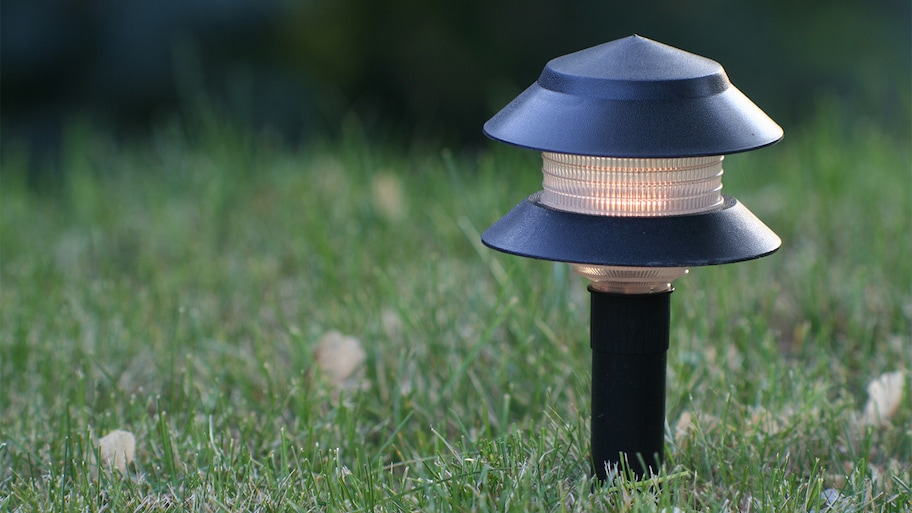How to Get Rid of Skunks and Keep Them Away: 6 Humane Methods
Politely prevent Pepé Le Pew from ponging up your porch


Unlike love-seeking Pepé Le Pew, the skunks venturing into your yard are usually just looking for free room and board. These shy, nocturnal critters are peaceful and unlikely to cause harm, but their reputation stinks for good reason.
To avoid being hit by their relentless reek, you don’t always have to call out local wildlife removal services. It pays to learn how to get rid of skunks humanely and stop them from circling back.
1. Set Up Catch and Release Traps
If trap and release is legal in your area, try the following:
Set up the trap: Place a large, raccoon-sized trap (at least 30 inches long) in a quiet spot you think the skunk regularly visits.
Disguise the trap: Layer it with leaves and soil.
Use yummy bait: Skunks love sardines, canned tuna, bacon, chicken gizzards, peanut butter, or fishy cat food. Marshmallows or mayonnaise will also work and won’t attract the neighbor’s cat.
Check the trap regularly: Approach the trap slowly and quietly, ideally every few hours. This avoids unnecessary, prolonged stress for the animal.
Cover and move: Use a thick towel, burlap, or canvas to cover the trap before moving, trying to stay out of the skunk’s sight and reach. This reduces the stress for the skunk and their chance of spraying you.
While catch-and-release is an effective, widely used solution, if you mess it up, you risk causing the skunk unnecessary stress—and they might spray you in the process. Plus, each state has varying laws and regulations on skunk removal. Some don’t allow live release, others only with specific trap types and in certain release locations. Local laws can even stipulate that only licensed professionals can release the skunks. Always check with your local Department of Wildlife Control before proceeding with trap attempts.
2. Evict From Their “Home”

Has a skunk taken up residence in a burrow under your home? Stopping them from getting back in can encourage them to move on to a new location.
Seal any cracks or holes along the foundations, but leave access to the main den hole.
During the day, sprinkle a layer of flour around the den when the skunk is snoozing in the den.
After dusk, check the flour every hour for skunk tracks.
When tracks appear leaving the burrow, temporarily seal up the entrance.
The following night, open the entrance for an hour, just in case any of the skunk family is still inside the burrow (from early May to mid-August, young skunks may still be in the den).
If you suspect a young family is in the burrow, it's better to call in the pros.
Once you’re sure no skunks are in the burrow, seal the entrance over permanently.
Alternatively, construct a one-way plywood door that allows the skunk to leave the den but not get back in.
Be on the lookout for damage in crawl spaces or underneath decking afterward. The cost of repairs after animal removal can reach as high as $5,000.
3. Use Skunk Repellents
It’s no wonder repellents are such a popular choice. You don’t have to worry about trapping and releasing skunks, they aren’t usually expensive, and you might even be able to use something already in your pantry.
While most repellents won’t do any harm, don’t expect miracles. No commercial formulas have specific registration for skunk use, and there’s no scientific proof they’re effective. You might still want to give them a whirl based on positive anecdotal reviews. Below are some to try.
Commercial Products
Liquid or granular repellents with strong odors could chase the skunks away. They often contain coyote urine or pepper, and you spray or sprinkle them around areas where there’s evidence of smelly critters.
DIY Skunk Repellents
Ironically, skunks aren’t fans of intense aromas. Fight stink with stink and create a DIY scent-based repellent. It’ll need frequent reapplication, though, especially after heavy downpours. Some options to try include:
Soap or room deodorizer: Place strong-smelling bars or pet-friendly sprays along the perimeter of your yard.
Citrus spray: Mix a cocktail of lemon or orange juice with water in a spray bottle.
Ultrasonic
When wildlife, like skunks, moves past these devices, the motion triggers a high-pitched noise that can scare them off. However, they can traumatize your pets, and your neighbors might not thank you for stressing out their wandering cat.
4. Try Capsaicin
Using a capsaicin-based product may help keep skunks away. Capsaicin is simply an ingredient made from hot peppers and you can find it in many repellants, including in a liquid or granule form for easy application. Skunks strongly dislike this taste and smell, so it may deter them. This humane deterrent doesn’t use poison or something that harms the animals.
5. Install Motion Lights
Skunks love to work the night shift. Installing bright motion lights around the home might give these light-sensitive critters enough of a spook that they’ll scurry away from the house for good.
6. Set off the Sprinklers

A sudden downpour ruins many people's days—and skunks are no different. Turning on the sprinklers when you see skunks or installing motion detection varieties is worth a shot.
What to Avoid When Trying to Get Rid of Skunks
You may be willing to try just about anything to get rid of skunks, but there are a few methods you may want to stay away from for your own safety or the skunk’s.
Avoid Ammonia and/or Mothballs
Using ammonia or mothballs to deter skunks may end up doing more harm than good. Ammonia is poisonous for baby skunks and extremely harmful to them, often resulting in death. It can also cause adult skunks to lose their eyesight. Mothballs also pose a threat to your dogs if eaten.
Don’t Use Predator Urine
You may have heard of using predator urine as a remedy for keeping skunks away, such as the urine from coyotes or dogs. This can work with some animals, but it doesn’t work with skunks. There’s also no way of knowing if the predator urine was harvested ethically.
Avoid Pesticides
Skunks enjoy eating insects (along with many other plants and small animals), so you may assume using pesticides in your yard will keep them away. However, pesticides can have harmful effects, and using them can disrupt the delicate ecosystem between insects and other living things in your yard.
Don’t Ignore Local Wildlife Laws
Lastly, you must abide by the local laws when trapping and removing skunks that damage your property. You can find out about these laws by contacting your state’s natural resource department.
While some municipalities allow property owners to trap and remove skunks when they’re disruptive, many states may require a permit for trapping them. Relocation is also another serious issue. It’s best to leave skunk removal up to a local pro.
How to Keep Skunks Away
After evicting existing stinkers, taking steps to keep skunks away from your home is a logical long-term game plan. There are plenty of simple strategies to put in place to keep them at bay.
Remove Food Sources
Offering a free meal ticket to local skunks is a surefire way to encourage them to repopulate your patio. Although they love bugs, skunks are scavengers and excellent diggers, so even food buried up to a foot is still at risk.
Lock up the trash cans and keep them out of reach of skunks, who aren’t expert climbers.
Put a pause on those potatoes or corn you’ve been trying to grow for a few weeks.
If you have pets, feed them indoors and keep their kibble in sealed containers.
Sweep up fruit and nuts that fall from trees.
Keep kitchen scraps out of the compost pile, or use a bin with a secure lid.
Clean up seed that spills from bird feeders at the end of every day.
Regularly mow your lawn to keep insects at bay.
Block Den Spots
Take a gander around your property for any shelter points that could become a skunk’s new burrow. This could be underneath a tree, in your crawl space, or below the decking. Seal up entry points and fill in holes.
Install Skunk-Proof Fencing
Installing a 3-foot (or higher) tight fence provides an extra barrier against skunks whose skills don't include jumping and climbing. You may need to bury the fence up to a foot deep to ensure the skunks don’t dig their way underneath. The cost of fence installation averages $2,600.
Why It’s Important to Get Rid of Skunks
Skunks might dig up prized plants or raid garbage in their search for dinner, but their infamous musk is the biggest concern. It won’t cause any permanent damage, but don’t underestimate its talent to torment.
Depending on the way the wind blows, you might get a whiff of an angry skunk from over a mile away. They have a surprisingly accurate aim from up to 10 feet away, and if they hit you, your pet, or items in your garden, the unpleasant odor lingers for days. Getting hit close-up can even cause temporary blindness, nausea, and respiratory issues.
Skunks, along with foxes, racoons, and bats, are also primary wildlife carriers of the rabies virus, so you don’t want to encourage them to stick around.
Signs of Skunks in Your Yard
Skunks are nocturnal and cautious creatures, so you might smell them before seeing them. Apart from a persistent, faint, and singularly unpleasant bouquet, some other signs these critters are hiding out around your home include:
Circular holes (usually around 4 inches deep) in your flower bed or lawn left by digging skunks looking for grubs
Munch marks in the lower leaves or ears of garden crops
5-toed paw print tracks just bigger than a cats
Rolled back sod
Tubed-shaped droppings
DIY vs. Hire a Pro
Calling in a licensed skunk removal professional near you means you don’t have to worry about falling foul of local removal regulations, there’s no risk of getting splurged with their spray, and it minimizes the stress for your temporary tenant.
You could always try DIY removal methods first, but if the skunk is especially stubborn, investing in professional help clears the air in no time. If local laws dictate, you might have no choice but to shell out for support.
If you spot a skunk out during the day acting odd, rabies is a risk. Always seek professional help if they show any of the following behaviors:
Circling
Paralysis
Disorientation
Seizing
Unprovoked aggression
A lack of wariness
Excessive vocalization
How Much Does Skunk Removal Cost?
Professional skunk removal cost is an average of $450. It varies between $300 and $600, depending on how many have invaded your patch, where they’ve set up home, and the removal method. Typically, pros use humane catch and release methods, often alongside baiting.
Opting for the DIY approach might cost you less than $100, but it takes time, isn’t always as successful as the pros, and you risk getting sprayed by a furious furry.
Because of the possibility of spraying, the cost of removal for all types of skunks is a little bit more than what is involved with general animal removal cost estimates. Expect to pay around $385 on average for wildlife animal removal not involving skunks.
Frequently Asked Questions
It’s possible that skunks will leave on their own. Skunks may appear briefly on your property and move on if they cannot find food. However, waiting them out is not a foolproof solution. If the skunk finds a food source on or near your property and builds a nest, the animal will almost certainly not choose to move. If you can eliminate food sources, you’ll have a better chance of seeing the skunk leave on its own.
Skunks are primarily active at night. If you are trying to keep skunks away, understand that you probably won’t see them moving much during the day, so you may struggle to measure your progress. However, daytime activity is possible if they have babies or are struggling to find food at night. A severely ill skunk could be moving around during the day as well. Skunks tend to be most active during the early spring months when seeking extra food or mates.
If you or your pet are unlucky enough to enrage a skunk during extraction, don’t douse yourself in tomato juice—it only masks the odor. A more effective way to get rid of skunk smells is with a hydrogen peroxide solution which you apply to skin, pet fur, or clothing.
